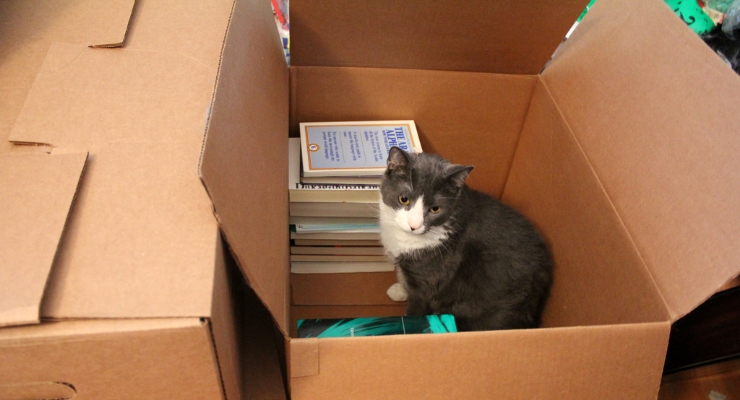
My son Zeke and his girlfriend, Jordan, moved into their first apartment in early July. Ricky, their 3-year-old ragdoll-cross, stayed with me until the moving commotion died down.
Then, one morning, Zeke picked Ricky up. “He was a little nervous and needed extra attention,” my son recalls. “He was doing OK, but he’d get upset if I came home from work late. He’d become very vocal.”
Moving with a cat can be a little difficult, especially if your cat is nervous when put into new situations and environments. Moving houses with a cat can be stressful for the both of you. However, there are a few things you can try to help alleviate some of the stress and trouble for both of you. Here are just a few tips for moving with a cat.
1. Plan Ahead Before Moving with a Cat
Kipling’s Cat That Walked by Himself didn’t really speak for his own kind. Real-life cats are territorial, and moving is, if anything, even more stressful for them than it is for us.
Pam Johnson-Bennett of Cat Behavior Associates says you should try to keep your cat’s routine as normal as possible before the big move.
“It will only add to his anxiety if meals are late or he doesn’t receive the same amount of attention from his family,” she says. “In fact, incorporate some extra play sessions to help with any increase in anxiety he may be experiencing during the packing stage.”
When moving with a cat, she also suggests that you start packing early, giving your cat plenty of time to investigate all those boxes. “You can actually make the packing process kind of fun if the cat can enjoy playing in empty boxes for a couple of weeks.”
For Ricky, the moving process was more drawn out. He watched Zeke’s room slowly grow emptier and emptier. The vanishing bed did trouble him some, and he lay in the middle of the empty room, pondering that for a few days.
But he had the easy-going ragdoll temperament. When it came time for him to join Zeke and Jordan in the new apartment, he left without a fuss.
2. Moving Day: No Loose Cats in the Car
Another tip for moving with a cat is to ensure they get used to their vehicle of transportation beforehand. Make sure your cat is used to being in a carrier before the move. You definitely don’t want him/her loose in the car.
The majority of cats do not view it as a good ol’ time. They tend to get frightened, even hysterical, and are infinitely better off in their carriers.
Many years ago, my mother-in-law, Bobbie, made a white-knuckled trip with a terrified cat trying to get under the brake pedal. The fact that there wasn’t an accident makes me believe in guardian angels and Bobbie’s superior driving skills.
Leaving your cat free in the car also makes it frighteningly easy for your feline to slip out along the way. That is precisely what happened to a friend of mine who was driving cross-country with a loose cat. Sadly, she never found her beloved pet.
So use a carrier — a good sturdy one that offers some protection from the elements as you’re transferring your cat from house to car to house. No mesh-top carriers need apply.
Tips for traveling with a cat:
- Feed your cat at least 3 hours before traveling to avoid an upset tummy.
- Don’t transport your cat in the cargo hold area of a vehicle or a moving truck. Instead, place the carrier on a seat and secure it with a seatbelt.
- Keep the temperature comfortable for your cat.
- If the trip is especially long, take a break to give your cat some water and to use the litter box.
Check out these extra tips for moving with a cat:
3. At the New Home: Set Up a Chillout Room
Remember that old line about being “as nervous as a cat in a room full of strange rockers?” It’s not only colorful, but it’s also very true.
Was YOUR Pet Food Recalled?
Check Now: Blue Buffalo • Science Diet • Purina • Wellness • 4health • Canine Carry Outs • Friskies • Taste of the Wild • See 200+ more brands…

When you arrive at your new place, find a nice out-of-the-way room. Set your cat up in it with food, water, a litter box and a few toys.
Then close that room, and don’t open it until the movers are done. This gives them the opportunity to adjust to one place before getting overwhelmed with a whole new house and movements going on with the moving-in process.
4. Consider Revoking Outdoor Privileges
If your cat had outdoor privileges at your old home, this might be a good time to change that, says Johnson-Bennett.
“You don’t know what kind of outdoor territorial issues might be going on with other cats, and he will be the new kid in town. He will have no connection to his new territory, so just letting him outside will greatly increase the chances of having him never return.”
International Cat Care disagrees, insisting that it “is never ideal to change your cat’s lifestyle from outdoor to indoor.”
I’m with Johnson-Bennett on this one. Your cat will adapt, and he/she will live a much longer life. When my brother moved, his cats made the switch from great outdoor hunters to indoor cats without a flick of their whiskers.
For Ricky, of course, the great outdoors is simply something to be surveyed from a window. He has adapted beautifully to his new place and his new little buddy, Mr. Rochester, one of the foster kittens he used to babysit here.
Here’s some tips on how to introduce a cat to a new home over the course of a few days:
- Introduce them to 1 room at a time.
- Keep an eye on them as they investigated so they don’t get stuck behind things like heavy-duty appliances, water heaters and sump pumps.
- Close all windows and doors tightly.
- Keep them indoors while they adjust to the new space.
Frequently Asked Questions (FAQ)
How long does it take a cat to adjust to a new home?
The time it takes for a cat to adjust to a new home can vary greatly depending on the individual cat’s temperament, age, and previous experiences. On average, it might take a few days to a couple of weeks for a cat to start feeling comfortable in their new home.
How to reduce cat stress when moving?
How to help a stressed cat when moving can vary depending on the cat and situation. For example, preparing in advance by acclimating your cat to carriers and travel equipment could help. Setting up a quiet, familiar room in the new home with some of their essentials before bringing them in is another way to try to help reduce their stress. Be patient and observe your cat’s behavior and adjust as needed to help them adapt smoothly to their new surroundings.
How to help a cat cope with moving?
Planning ahead and making the process as easy on your cat as possible can be a way to help them cope with moving, such as by keeping up routine and introducing them to the new place gradually. A few other tips for moving with a cat include bringing in familiar items and setting up a safe, quiet space for them could help provide comfort in the new house.
* * *
Katie Jenison contributed to this article.



